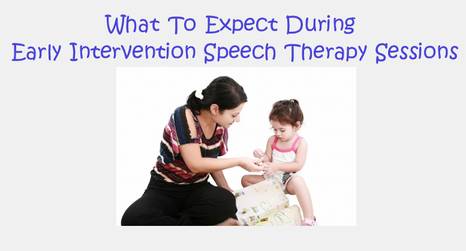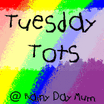Speech therapy is usually provided in your toddler’s natural environment because this is where he is most comfortable and functions the best. That means that he will receive therapy in the home or childcare setting. Occasionally, therapy may take place in a clinic or office setting. The frequency (how much) and duration (how long) of speech therapy will be determined during the meeting to create the Individualized Family Service Plan (IFSP).
What happens during your toddler’s first speech therapy session?
The speech-language pathologist (SLP) will establish rapport with your toddler. This typically involves sitting on the floor and playing with your child. It may take more than one session to accomplish it, too. She may bring her own toys or want to play with your toddler’s toys. The key is to let your toddler know that she is fun! It is very important that the SLP make your toddler feel comfortable with her so that she can have success with future therapy sessions.
The SLP may also ask you, the parent or caregiver, even more questions regarding your child’s speech and language development, likes, and dislikes. She may even give you tips on how to play with your toddler and stimulate his speech and language skills.
What happens during your toddler’s other speech therapy sessions?
Your toddler’s SLP will make a visit one to several times a week depending on what was written in the IFSP. Sessions usually start off with a rapport building activity (sort of like an ice breaker). This may include singing a song, greeting the child, or playing with a toy.
Next, the actual speech therapy session will begin. The SLP will work toward a set of goals that were established during the IFSP meeting to help your toddler communicate . Keep in mind that it is very important that you give your input at the IFSP meeting as a parent as to what you would like your child to accomplish during speech therapy. You are an essential part of the process and can help set your toddler’s speech therapy goals.
Early intervention speech therapy sessions are play based. All children and toddlers learn through play. Play is fun and is a natural part of a child’s development. Play also creates the desire for your toddler to talk and communicate. According to the American Academy of Pediatrics, “Play allows children to use their creativity while developing their imagination, dexterity, and physical, cognitive, and emotional strength.” Your toddler’s speech therapy sessions may include playing with toys, playing outside, singing age-appropriate songs, and arts and crafts.
During or after the speech therapy session the SLP will talk to you about your concerns and questions regarding your toddler’s speech and language skills. She will also give you tips, resources, and information about how to work with your toddler between therapy sessions. This may include how to play with your child or how to stimulate language during daily routines. It is very important to remember that you, the parent or caregiver, are your toddler’s best teacher. The SLP only comes once or a few times a week, but you are with your child the most. Therefore, you are a key part to increasing your toddler’s speech and language development!
Remember that if you suspect your toddler may have a speech-language delay to get him evaluated as soon as possible. Speech therapy can make a big difference in your toddler’s life as well as your life as a parent!
To learn how you can help your toddler talk and communicate faster, be sure to check out my book on Amazon Kindle, Talking With Todders - 52 Tips to Boost Speech and Language Skills.


 RSS Feed
RSS Feed



